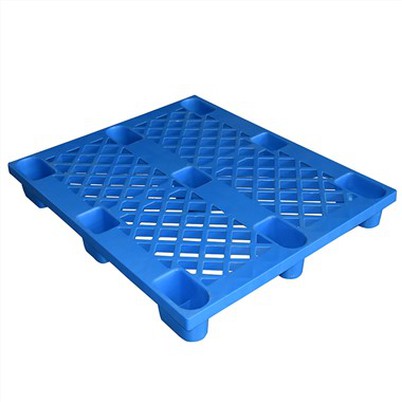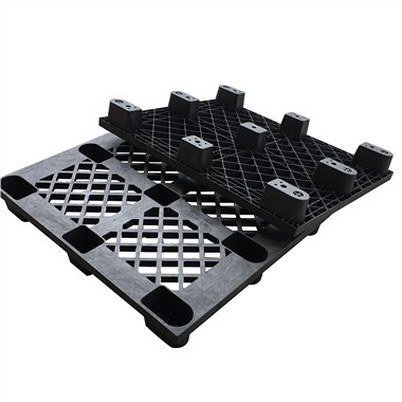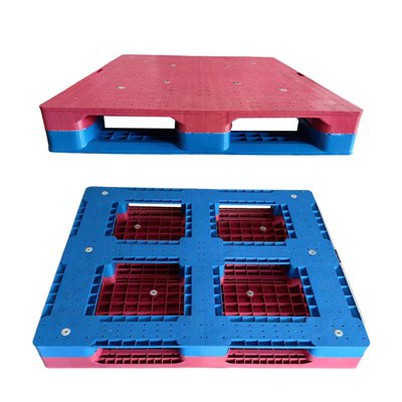Are 9 feet nestable pallets compatible with conveyor systems?
Leave a message
Are 9 Feet Nestable Pallets Compatible with Conveyor Systems?
In the dynamic world of logistics and warehousing, the compatibility between pallets and conveyor systems is a critical consideration. As a supplier of 9 feet nestable pallets, I've encountered numerous inquiries regarding their suitability for use with conveyor systems. This blog aims to delve into this topic, exploring the factors that determine compatibility and providing insights to help businesses make informed decisions.
Understanding 9 Feet Nestable Pallets
Before discussing compatibility, it's essential to understand what 9 feet nestable pallets are. These pallets are designed to be 9 feet in length, which is a relatively large size compared to standard pallets. The "nestable" feature means that when not in use, the pallets can be stacked inside one another, reducing storage space requirements significantly. This makes them an ideal choice for businesses looking to optimize their storage and transportation efficiency.


Our 9 feet nestable pallets are made from high - quality materials, ensuring durability and strength. They are suitable for a wide range of industries, including food and beverage, pharmaceuticals, and manufacturing. The large size allows for the transportation of bulky or large - volume goods, while the nestable design provides cost - effective storage solutions.
Factors Affecting Compatibility with Conveyor Systems
1. Dimensions and Weight
The dimensions of the 9 feet nestable pallets are a primary factor in determining compatibility with conveyor systems. Conveyor systems are designed to handle pallets of specific sizes and weights. The length of 9 feet is a significant consideration, as many standard conveyor systems may not be long enough to accommodate such pallets. Additionally, the weight capacity of the conveyor must be sufficient to handle the load carried by the pallet and its contents.
It's crucial to measure the conveyor's width, length, and height clearance to ensure that the 9 feet nestable pallets can move smoothly through the system without getting stuck or causing damage. Our pallets are designed with standard dimensions in mind, but it's always advisable to consult with the conveyor system manufacturer to confirm compatibility.
2. Pallet Design and Structure
The design and structure of the 9 feet nestable pallets also play a vital role in compatibility. The pallet's bottom structure, such as the number and arrangement of runners or blocks, must be compatible with the conveyor's rollers or belts. For example, if the conveyor has narrow rollers, the pallet's runners should be spaced in a way that allows for stable movement.
Our nestable pallets are engineered with a robust and well - thought - out design. The bottom structure is optimized for smooth movement on conveyor systems, with even weight distribution to prevent tilting or jamming. The nesting feature is also designed to ensure that the pallets do not interfere with the conveyor's operation when stacked or unstacked.
3. Conveyor System Type
There are different types of conveyor systems, including roller conveyors, belt conveyors, and chain conveyors. Each type has its own requirements and limitations when it comes to pallet compatibility.
- Roller Conveyors: Roller conveyors rely on the rotation of rollers to move pallets. The 9 feet nestable pallets must have a bottom surface that can roll smoothly on the rollers. Our pallets are designed with a flat and smooth bottom to ensure efficient movement on roller conveyors.
- Belt Conveyors: Belt conveyors use a continuous belt to transport pallets. The pallets must have a surface that can grip the belt without slipping. Our pallets have a textured surface that provides sufficient friction to move steadily on belt conveyors.
- Chain Conveyors: Chain conveyors use chains to move pallets. The pallets need to be compatible with the chain's movement and have a structure that can withstand the forces exerted by the chains. Our pallets are built with a strong and durable structure to handle the demands of chain conveyors.
Benefits of Using Compatible 9 Feet Nestable Pallets on Conveyor Systems
1. Increased Efficiency
When 9 feet nestable pallets are compatible with conveyor systems, it leads to increased efficiency in the supply chain. Pallets can move quickly and smoothly through the system, reducing handling time and minimizing the risk of product damage. This results in faster order fulfillment and improved customer satisfaction.
2. Cost Savings
Efficient conveyor system operation means reduced labor costs and lower energy consumption. With compatible pallets, the conveyor system can operate at its optimal capacity, eliminating the need for manual handling and reducing the risk of system downtime. Additionally, the nestable design of the pallets reduces storage costs, as more pallets can be stored in a smaller space.
3. Improved Safety
Compatible pallets on conveyor systems reduce the risk of accidents and injuries. When pallets move smoothly through the system, there is less chance of jams or collisions, which can cause damage to products and equipment and pose a safety hazard to workers. Our pallets are designed with safety in mind, with rounded edges and a stable structure to prevent tipping.
Real - World Examples and Case Studies
We have worked with several clients in various industries to ensure the compatibility of our 9 feet nestable pallets with their conveyor systems. One client in the food industry was looking to upgrade their logistics operations to handle larger volumes of products. They had a conveyor system in place but were struggling to find pallets that could accommodate their large - sized products and move smoothly through the system.
After a detailed analysis of their conveyor system and product requirements, we recommended our 9 feet nestable pallets. The pallets were customized to fit the conveyor's dimensions and weight capacity. Once installed, the client experienced a significant improvement in efficiency, with faster product movement and reduced handling time. The nestable design also allowed them to save on storage costs, as they could stack more pallets in their warehouse.
Other Pallet Options for Conveyor Systems
In addition to our 9 feet nestable pallets, we also offer other types of pallets that may be suitable for conveyor systems. You can explore our used nestable plastic pallets, which are a cost - effective option for businesses on a budget. These pallets are in good condition and can provide reliable performance on conveyor systems.
Our Nestable Disposal Plastic Pallet is another option. These pallets are designed for single - use or short - term applications and are ideal for industries that require disposable pallets for hygiene or cost - saving reasons.
For businesses looking for a one - time use solution, our One Way Plastic Pallet is a great choice. These pallets are lightweight and can be easily transported on conveyor systems, making them suitable for export and distribution.
Conclusion and Call to Action
In conclusion, 9 feet nestable pallets can be compatible with conveyor systems, but it requires careful consideration of factors such as dimensions, weight, pallet design, and conveyor system type. As a supplier of high - quality 9 feet nestable pallets, we are committed to providing our customers with the best solutions for their logistics and warehousing needs.
If you are interested in learning more about our 9 feet nestable pallets and their compatibility with your conveyor system, or if you want to explore our other pallet options, please feel free to contact us. Our team of experts is ready to assist you in making the right choice for your business. We can provide detailed product information, conduct on - site assessments, and offer customized solutions to ensure that your pallets and conveyor systems work together seamlessly.
References
- "Warehousing and Distribution Center Operations" by Edward F. Frazelle
- "Logistics Management and Strategy" by Martin Christopher
- Industry reports from the Material Handling Industry of America (MHIA)






